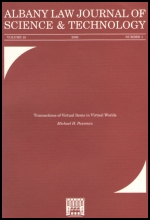Recent Target Settlement Raises Questions About Virtual World Access for Users with Disabilities
October 6th, 2008 by Benjamin Duranske
 Users with disabilities access virtual worlds on the 3D internet to run businesses, socialize without stigmas, and learn in new ways. There’s even a “Virtual Ability” island in Second Life (originally funded by the National Library of Medicine and maintained through private donations) devoted to accessibility for disabled users. Just like the real world, however, virtual worlds pose access problems for disabled users. Vision-impaired users struggle with tiny on-screen interface elements, users lacking fine-motor control or use of extremities have trouble with keyboard and mouse controls, and hearing-impaired users are limited in ever-increasing voice communication. Third-party software and hardware helps, but businesses and educational institutions with virtual world presences could do more to enhance accessibility themselves — and some argue they may be obligated to do so under disability discrimination laws.
Users with disabilities access virtual worlds on the 3D internet to run businesses, socialize without stigmas, and learn in new ways. There’s even a “Virtual Ability” island in Second Life (originally funded by the National Library of Medicine and maintained through private donations) devoted to accessibility for disabled users. Just like the real world, however, virtual worlds pose access problems for disabled users. Vision-impaired users struggle with tiny on-screen interface elements, users lacking fine-motor control or use of extremities have trouble with keyboard and mouse controls, and hearing-impaired users are limited in ever-increasing voice communication. Third-party software and hardware helps, but businesses and educational institutions with virtual world presences could do more to enhance accessibility themselves — and some argue they may be obligated to do so under disability discrimination laws.
 The most recent news on this front is a $6 million settlement of a lawsuit between Target and the National Federation of the Blind regarding Target’s website. The NFB had sued Target arguing that Target’s site was not accessible to visually impaired users. Anikto — a company providing digital accessibility services — has some excellent analysis of this settlement on its blog:
The most recent news on this front is a $6 million settlement of a lawsuit between Target and the National Federation of the Blind regarding Target’s website. The NFB had sued Target arguing that Target’s site was not accessible to visually impaired users. Anikto — a company providing digital accessibility services — has some excellent analysis of this settlement on its blog:
Although the ADA states that places of public accommodation must be accessible to the disabled, websites are not mentioned as an example of such. The NFB was thus forced to consider Target.com not as a physical place, but as a service and benefit offered by Target Corp by way of stores located in California.
[...T]he settlement is ultimately a good leap forward. The fact that the case was heard at all, and that a settlement favorable to the Plaintiff was reached, indicates that web accessibility is becoming more than a frivolous side-topic of nominal interest. Decisions made in state law can hopefully create the leverage necessary to force businesses to evaluate their e-commerce policies.
Although the Target settlement is about a 2D website, not a virtual world, it has clear applicability to 3D spaces. The argument is that both state law (particularly California’s disability discrimination law) and the Americans with Disabilities Act of 1990 can be applied to compel greater accessibility to web-based services. Under this theory, educational and enterprise virtual-world users (such as colleges requiring student attendance in virtual-world classrooms and businesses with both “click” and “brick” presences) could also be obligated to make their virtual world builds more accessible to disabled users.
Although specific to games, an interesting article by “Dwarf Priest” regarding World of Warcraft creator Blizzard’s commitment to disabled gamers cites statistics showing that between 5% and 10% of game players have disabilities. Presumably, the numbers for social virtual worlds would be similar.
This is one area where virtual law could lead more general internet law. From a practical perspective, a non-technical fact-finder is going to more easily see a 3D virtual classroom with seats, a lectern, and a big screen showing PowerPoint presentations as a “public accommodation” under the ADA or similar state laws than a less obviously analogous 2D website, wiki, or course blog.
Applying disability discrimination laws to electronic resources is controversial, and would represent a major reinterpretation of these laws. Walter Olson, who maintains Overlawyered.com (a site chronicling the costs of the U.S. legal system) argues that applying the ADA and similar state laws to electronic resources will stifle innovation and that the move poses a “serious threat to the freedom, spontaneity and continued growth” of the 2D web. Presumably, Mr. Olson’s argument (set forth before the emergence of virtual worlds) would apply to the 3D internet as well.
This issue is likely to arise more often as more jobs, educational opportunities, and government resources depend on access to electronic resources — both on 2D websites and, particularly, on the emerging 3D internet.
Related Posts on Virtually Blind
- Lawspot Library and the Galileo Law Directory: "Second Life's 'Cat Galileo,' a real life and Second Life law..." (3 comments)
- The Legality of the Virtual World’s Oldest Profession: "The Second Life Herald has an article up that beat me to some..." (16 comments)
- Virtual Law in the News – Links and Excerpts: "Lots of blog entries and articles on virtual law recently. Here are a..." (0 comments)


 This edition of Virtually Blind’s
This edition of Virtually Blind’s 
 MDY Industries has agreed to pay World of Warcraft creator Blizzard $6,000,000 in damages arising from the use of MDY’s
MDY Industries has agreed to pay World of Warcraft creator Blizzard $6,000,000 in damages arising from the use of MDY’s 